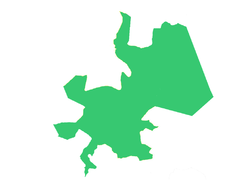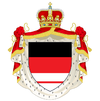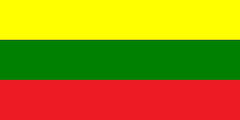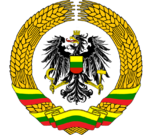Daikoku Federation
This article refers to a micronation or element of micronationalism which is defunct and no longer exists. You can help make the article reflect that or ask on the talk page for further information. |
Daikoku Federation Pederasyong Daikoku | |||||||||||
|---|---|---|---|---|---|---|---|---|---|---|---|
| Motto: Progress, Unity, Struggle | |||||||||||
| Anthem: Song of Great Daikoku | |||||||||||
 Manila, Philippines | |||||||||||
| Capital and largest city | Seidaikei | ||||||||||
| Official languages | English, Filipino | ||||||||||
| Demonym(s) | Daikoku | ||||||||||
| Government | Constitutional parliamentary federation | ||||||||||
| Migs Caldeo Karlos Luis Mozo Anioay | |||||||||||
• Premier | Marius Reyes | ||||||||||
| Legislature | Federal Assembly | ||||||||||
| Establishment | 13 April 2013 | ||||||||||
| Population | |||||||||||
• Registered 1,242,266 Permanent residents census | 29 | ||||||||||
| Time zone | UTC +8 | ||||||||||
| |||||||||||
The Daikoku Federation, or Pederasyong Daikoku, or Daikoku in short form, is a territorial federal sovereign micronation located in the Philippines. It consists of two constituent states, the Democratic People's Republic of Urbonia and the Principality of Treisia, and one federal state, the capital city of Seidaikei. It covers a total area of 86.93 square kilometers and has a tropical climate. It has a total population of 29.
On 3 November 2014, after the dissolution of the Kingdom of Treisia, the Daikoku Federation dissolved itself and formed the Republic of Daikoku.[1]
Etymology
The name Daikoku originated from two Japanese words, dai (大), which means "great", and koku (國), which means "country".
History
People's State of San Andreas
The history of the Daikoku Federation can be traced back to the People's State of San Andreas, a micronation established by Co-President Migs Caldeo on May 7, 2012.
The People's State of San Andreas was a territorial micronation with territories in the Philippines, Europe, Southeast Asia and North America. It was a presidential constitutional republic, with Co-President Migs Caldeo as its president, with the People's Assembly being its legislature.
On January 2013, President Migs Caldeo and the National People's Party won the second general elections held in the country, and this resulted into the transition of the country to the Democratic People's Republic of Urbonia, which was a parliamentary republic.
Principality of Treisia
The history of the Daikoku Federation can also be traced back to the Principality of Treisia, a micronation established by Co-President Karlos Luis Mozo Anioay on February 25, 2013.
The Principality of Treisia was a territorial micronation located in the Philippines and it shared its borders with the Democratic People's Republic of Urbonia. It is a principality with Karlos Luis Mozo Anioay as its grand prince.
The Principality was considered to be an ally of the Democratic People's Republic of Urbonia since its head of states of the respective countries were known to be allies. The friendship between Co-Presidents Caldeo and Anioay would bring about the creation of the Daikoku Federation.
Democratic People's Republic of Urbonia and Operation Nadeko
In January 2013, President Migs Caldeo had announced that San Andreas would enter into a transitional period to the Democratic People's Republic of Urbonia through the Dissolution Act. The act placed the entire country under the supreme leadership of the President and detailed how the transition process would be carried out. It also stated that the transition to the new country would end on May.
The transition period, however, was plagued by violence as a coup orchestrated by dissident members of the People's Assembly and by the People's Security Force was carried out on February 21 after they became dissatisfied with the nation's policy of not having an armed forces. The coup plotters installed General Vince Tambaoan as president.
President Caldeo, in return, declared the early establishment of the DPRU on the same day, and vowed to defend his government, the legitimate government of the republic.
On February 22, 2012, the coup plotters surrendered and agreed to the ultimatum of the government. The two sides began negotiations on the creation of a new government on the same day, but negotiations between the government and the coup plotters soon deteriorated as the coup plotters launched another coup.
Since most of the Urbonian government had participated in the coup, President Caldeo called on Grand Prince Karlos Luis Mozo Anioay of the Principality of Treisia in order to bring an end to the coup.
President Caldeo and Grand Prince Anioay orchestrated a counter-coup which was called Operation Nadeko. It involved a simultaneous attack by loyal Urbonian forces and the Treisian Internal Defense Force headed by Margrave Jeremy Celespara on the city of Shiro-shi, the capital of the Urbonian republic. Operation Nadeko was launched on February 28, and it resulted in the surrender and arrest of the coup plotters.
After the coup, the Urbonian republic tried to rehabilitate the nation and the government with a new constitution signed on March 6 and the installment of Patrick Nuguid as prime minister. Prime Minister Nuguid, however, failed to create a new government and resigned on March 21. He was succeeded by Prime Minister Noel Cabe, but he too failed to create a new government.
The failure to create a new government convinced President Migs Caldeo to create a federal state between Urbonia and Treisia. He entered into secret negotiations with Grand Prince Karlos Luis Mozo Anioay in early April to form the Daikoku Federation.
Daikoku Federation
On April 13, 2013, a summit was held between the leaders of the Democratic People's Republic of Urbonia and the Principality of Treisia, and it resulted with the signing of the Treaty on Unification and the Creation of a Federal State. The treaty formally established the Daikoku Federation with President Migs Caldeo and Grand Prince Karlos Luis Mozo Anioay being the heads of states as members of the Federal Executive Commission, and Urbonia and Treisia becoming constituent states of the federation.
On May 25, 2013, the constitution of the Daikoku Federation was ratified by both the Federal Executive Commission and the Constitutional Commission. The Federal Executive Commission became the Presidency of the Daikoku Federation, the executive body of the government, and it appointed Patrick Xavier Silerio as the federation's first premier.
Elections to the 1st Federal Assembly were held on June 21, resulting in the People's Party of Urbonia winning all of the seats in Urbonia, and independents endorsed by the government winning all of the seats in Treisia. The deputies to the 1st Federal Assembly later formed the Daikoku People's Front, the current ruling party in the Daikoku Federation.
On June 28, 2013, Patrick Xavier Silerio was re-appointed premier by the Presidency after a unanimous vote by the Federal Assembly.
Territorial arose between the Daikoku Federation, the State of Ariana and the Republic of Kaleido after the federation annexed Misaka District on August 26, 2013. The territory comprising Misaka District was under the jurisdiction of both the State of Ariana and the Republic of Kaleido, which the Daikoku Federation was not aware of. Initial negotiations between the three states began on September 21, 2013, with the negotiations failing on September 30 as the a referendum in the federation voted to end talks with Kaleido, and restart talks with Ariana.
Negotiations between the Daikoku Federation and the State of Ariana were restarted on October 2, 2013, which were concluded on October 23, 2013 with a signing of a treaty.
On October 16, 2013, the Federal Assembly voted for no confidence on the government of Patrick Xavier Silerio. Parliamentary elections were held on October 26, where the Daikoku People's Front unanimously won, with a new government under Premier Marius Reyes being formed on November 1.
Government and politics
The Daikoku Federation is a federal parliamentary federation, with a constitution approved on May 25, 2013.
The executive body of government consists of the Presidency and the Government.
The Presidency is the collective head of state of the Daikoku Federation and it consists of the President of Urbonia and the Grand Prince of Treisia - President Migs Caldeo and Grand Prince Karlos Luis Mozo Anioay, respectively. The Presidency is filled through various ways, with the President of Urbonia through elections in that constituent state and the Grand Prince of Treisia through succession. The Presidency is the guarantor of the constitution of the Daikoku Federation and is the representative of the nation in foreign affairs. It has the powers to issue decrees, and appoint the Premier and the Government.
The Premier is the head of the Government of the Daikoku Federation. This position is currently held by Marius Reyes. The Government is composed of five ministries and it is responsible for all matters in relation to state administration.
The legislative body of government consists of the unicameral 4-member Federal Assembly. It serves as the parliament of the Daikoku Federation and it has the powers to make laws, and to express no confidence in the Government. The Daikoku People's Front currently holds all of the seats in the Federal Assembly.
The judicial body of government consists of the Federal Assembly, which is headed by Supreme Judge Patrick Xavier Silerio and Deputy Judge Luis Angelo Gutierrez. It is responsible for administering justice through trial.
The Daikoku Federation practices a multi-party system of government. Since winning the first elections held in the country, the Daikoku People's Front has dominated the government with all ministers of government and deputies to the Federal Assembly being its members.
Administrative divisions

The Daikoku Federation is divided into two constituent states and one federal state. The constituent and federal states are further divided into districts. The two constituent states of the Daikoku Federation have the rights to have their own sovereignty, government, constitution and representation to the Federal Assembly, while the federal state of Seidaikei is under the governance of the Presidency of the Daikoku Federation.
| Flag | Emblem | Name | Capital | Population | Area (m²) | Head of State | Deputies to the Federal Assembly | Legislature | ||||
|---|---|---|---|---|---|---|---|---|---|---|---|---|
| Constituent States | ||||||||||||

|

|
Democratic People's Republic of Urbonia | Nakatani | 10 | 41.99 | President Migs Caldeo | Dave Badiola, Noel Cabe | People's Assembly | ||||

|

|
Principality of Treisia | Greater Treisia | 19 | 37.43 | Grand Prince Karlos Luis Mozo Anioay | Jeremy Gabriel Celespara, Marius Reyes | Council of Ministers | ||||
| Federal State | ||||||||||||

|

|
Seidaikei | 0 (citizens of constituent states may be living here) | 7.51 sq. km. | ||||||||

